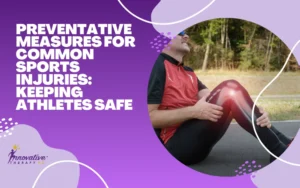Sciatica is more than just a pain in the back. It’s a pain that runs deep physically and emotionally, affecting every facet of daily life.
The good news?
There are multiple treatments available that can provide relief.
In this article, we will delve into the various sciatica treatments, how they work, and how Innovative Therapy PC can be your partner in the journey to a pain-free life.
Let’s Dive In!
9 Treatments For Sciatica Pain

1. Heat and Ice Treatment
When sciatica strikes, your first defense might be the simplest. Using ice during the initial phase can help combat inflammation. After 48 hours, transitioning to heat can soothe muscles and increase blood flow. To utilize this method:
- Start with a cold pack on the affected area for 15-20 minutes.
- After a couple of days, switch to a hot pack or a warm bath.
- Avoid direct skin contact to prevent burns or frostbite. Always use a towel or cloth barrier.
2. Osteopathy
This holistic approach addresses the entire body, not just the pain point.
By improving spinal posture and correcting biomechanical imbalances, osteopathy can alleviate the root causes of sciatica.
It involves manipulative techniques that enhance spinal health and mobility, thus reducing nerve impingement.
3. Acupuncture
Acupuncture uses thin needles to target specific energy points to redirect and balance energy flow.
Regarding sciatica, this can translate to pain relief and muscle relaxation, helping address nerve irritation.
Many patients report a reduction in pain and a surge in overall well-being.
4. Massage Therapy

Beyond relaxation, massage offers therapeutic benefits for sciatica. Targeting muscle tension, especially in the lower back and buttocks, can release pressure points.
At Innovative Therapy PC, therapists employ techniques like deep tissue and trigger point therapy, focusing on areas contributing to sciatica.
5. Sciatica Treatments Stretches
Flexibility can be a potent weapon against sciatica. Regular stretches targeting the lower back and hip region can alleviate the tightness and pressure on the sciatic nerve.
Over time, these stretches can offer immediate relief and increase the overall range of motion, making one less susceptible to sciatica flare-ups.
6. Sciatica Treatment Exercises
Strengthening the surrounding muscles can support the affected region, reducing the chances of future flare-ups.
Plank:

It is an excellent core strengthener that supports your spine.
Benefits:
- Engages and strengthens the entire core.
- It provides more support to the lumbar spine, which can reduce pressure on the sciatic nerve.
How to Perform:
- Start by lying face-down on a soft surface or mat.
- Place your elbows directly below your shoulders, forearms flat on the ground, fingers facing forward.
- Extend your legs straight behind you, toes touching the ground.
- Tighten your abdominal muscles and lift your body off the ground so you’re supported only by your forearms and toes.
- Keep your body in a straight line from head to heels without sagging at the hips.
- Hold the position for 20-30 seconds, breathing normally. As your strength improves, increase the duration.
- Lower yourself slowly back down and rest before repeating.
Knee-to-chest stretch:

A soothing stretch for the lower back and glutes.
Benefits:
- Relieves tightness in the lower back and buttocks, often associated with sciatic pain.
How to Perform:
- Lie flat on your back on a comfortable surface or mat.
- Extend your legs straight out in front of you.
- Slowly bend one knee, pulling it up towards your chest using both hands. Ensure the other leg remains straight.
- Hold the position for 20-30 seconds, feeling a stretch in your glutes and lower back.
- Release the leg slowly back to its original position.
- Repeat with the other leg.
Sciatic nerve mobilization:
It helps in enhancing the flexibility of the nerve, reducing stiffness.
Benefits:
- Improves mobility and flexibility of the sciatic nerve.
- Reduces nerve tension, offering relief from pain.
How to Perform:
- Lie on your back on a soft surface or exercise mat.
- Fully extend both legs in front of you.
- Raise one leg, holding the back of your thigh, just above the knee, with both hands. The other leg remains flat on the ground.
- Keeping your hands where they are, attempt to straighten the knee of your raised leg. This movement will cause your foot to move towards the ceiling.
- Slowly bend the knee, bringing the foot back down but lifting the thigh.
- Perform this straighten-and-bend motion ten times, then switch to the other leg.
Incorporating these exercises into your daily routine can be a powerful way to combat sciatica symptoms. However, always consult a healthcare professional before starting any exercise regimen, especially when dealing with sciatica.
7. Limited Bed Rest

While the immediate reaction to intense pain might be to lie down and rest, it’s essential to understand that prolonged bed rest can be detrimental to sciatica.
Staying active ensures muscles remain engaged, promoting blood flow and preventing stiffness. However, it’s also crucial not to overstrain.
Combining limited bed rest with gentle movements, a balanced approach often yields the best results.
8. Diskectomy
In cases where conservative treatments don’t provide relief, surgical intervention might be considered.
Diskectomy involves removing the portion of the herniated disk pressing on the sciatic nerve.
It’s generally reserved for severe cases where the compressed nerve leads to significant weakness, loss of bowel or bladder control, or when the pain worsens.
9. Laminectomy
Another surgical option, laminectomy, involves removing the bone (lamina) pressing against the nerve or nerves, relieving pressure and pain.
While surgery always comes with risks, it provides the much-needed respite from persistent, debilitating sciatica pain for some.
Also Read On Sciatica Pain
- Complete Sciatica Pain Guide – Symptoms, Causes, Diagnosis, Tests, and Essential Treatments
- Unlock Relief: Effective Sciatica & Lower Back Pain Exercises for Your Active Lifestyle
FAQs About Sciatica Treatments
How many treatments for sciatica with a chiropractor?
The number of treatments required by a chiropractor varies depending on the severity of the symptoms and the individual’s response to treatment. On average, many people notice improvement within 1-4 sessions. However, some may require more prolonged treatment, especially if the sciatica has been present for extended periods. A chiropractor will typically establish a treatment plan based on an initial assessment.
How many acupuncture treatments are needed for sciatica?
Like chiropractic care, the number of acupuncture sessions needed for sciatica varies with the individual and the severity of their condition. Typically, some relief can be observed after the first session. However, 6-12 treatments might be recommended for lasting relief. Regular maintenance sessions might also be advised.
How many chiropractic treatments for sciatica?
This question mirrors the first, but to reiterate, the number of chiropractic treatments for sciatica depends on the individual and the severity of their condition. Some might find relief within a few sessions, while others might need ongoing treatment spanning several weeks or months.
What are treatments for sciatica?
Sciatica treatments encompass a wide range of modalities, both non-surgical and surgical. They include physical therapy, chiropractic adjustments, acupuncture, massage therapy, heat and ice therapy, stretching and exercise routines, over-the-counter pain relievers, prescription medications, epidural steroid injections, and, in severe cases, surgery like a diskectomy or laminectomy.
What is the fastest way to cure sciatica?
There’s no one-size-fits-all “fastest” treatment for sciatica, as its effectiveness depends on the root cause of the pain. However, some people find immediate relief from cold packs, over-the-counter pain medications, and gentle stretching. For others, treatments like chiropractic adjustments or acupuncture provide swift relief. It’s essential to consult with a healthcare provider to determine the best approach.
What should you not do with sciatica?
Avoid heavy lifting, prolonged sitting, and sudden twisting movements if you have sciatica. High-impact exercises like jumping or running can also exacerbate symptoms. Additionally, it’s essential to maintain proper posture and avoid sleeping on a very soft mattress.
What triggers sciatica?
Various factors can trigger sciatica. The most common is a herniated or slipped disc that presses on the nerve roots. Other triggers include lumbar spinal stenosis (spinal canal narrowing in the lower back), degenerative disc disease, spondylolisthesis (where one vertebra slips over another), pregnancy, muscle spasms, or tumors.
Can I treat sciatica myself?
While home remedies and exercises can relieve sciatica symptoms, it’s essential to have a proper diagnosis to ensure that the underlying cause is addressed. Mild sciatica can benefit from self-care measures like cold and heat therapy, OTC pain medications, and gentle stretches. However, if the pain persists or worsens, seeking professional medical advice is crucial.
How to cure sciatica permanently?
Achieving a permanent cure for sciatica depends on its cause. Conservative treatments, physical therapy, and lifestyle changes (like improving posture, ergonomics, and regular exercise) can offer lasting relief for many. In some cases, mainly when caused by structural issues in the spine, surgery might be necessary to provide a permanent solution.
Conclusion
While common, sciatica can be a debilitating condition affecting one’s quality of life.
With numerous treatments available, it’s essential to understand the root cause to apply the most effective remedy.
Whether through chiropractic adjustments, acupuncture, or surgical procedures, lasting relief is achievable.
At Innovative Therapy PC, we strive to guide our patients on their journey to recovery, ensuring they receive the best care tailored to their needs.
If you or a loved one is grappling with sciatica, don’t hesitate to reach out and begin the path to a pain-free life.






2 Responses